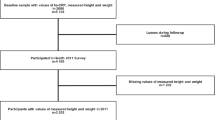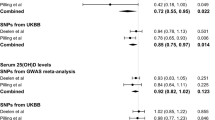Abstract
We aimed at estimating additive genetic heritability, household component effect and the influence of common alleles of the apolipoprotein E gene (APOE) on serum high-sensitivity C-reactive protein (hs-CRP) concentrations and the subsequent changes over 5 years. A sub-sample of 320 nuclear families was randomly selected from the Stanislas Family Study. Serum hs-CRP concentration was measured by immunonephelometry at entrance and after 5 years. APOE alleles were determined by restriction fragment length polymorphism. After adjustment for covariates, the number of the ɛ4 allele was negatively associated with serum concentration of hs-CRP in the whole sample, at entrance and 5 years later, without significant interaction with sex by generation groups (P=0.003 and P=0.0003, respectively). However, no significant association was found between ɛ4 allele and 5-year changes in hs-CRP concentration. Using a variance component analysis, no significant genetic influence was shown in family aggregation of both hs-CRP measurements and 5-year changes; the household common component was between 6.5 and 12.8%. In addition, after adjustment for APOE gene polymorphisms, degrees of resemblance were almost unchanged. In the Stanislas Family Study, ɛ4 allele of the APOE gene was associated with lower hs-CRP concentration, but not with 5-year changes. However, variance component analysis did not evidence a significant polygenic effect.
This is a preview of subscription content, access via your institution
Access options
Subscribe to this journal
Receive 6 digital issues and online access to articles
$119.00 per year
only $19.83 per issue
Buy this article
- Purchase on Springer Link
- Instant access to full article PDF
Prices may be subject to local taxes which are calculated during checkout
Similar content being viewed by others
References
Libby P . Inflammation in atherosclerosis. Nature 2002; 420: 868–874.
Pearson TA, Mensah GA, Alexander RW, Anderson JL, Cannon III RO, Criqui M et al. Markers of inflammation and cardiovascular disease: application to clinical and public health practice: a statement for healthcare professionals from the Centers for Disease Control and Prevention and the American Heart Association. Circulation 2003; 107: 499–511.
Ballantyne CM, Nambi V . Markers of inflammation and their clinical significance. Atheroscler Suppl 2005; 6: 21–29.
Bermudez EA, Rifai N, Buring JE, Manson JE, Ridker PM . Relation between markers of systemic vascular inflammation and smoking in women. Am J Cardiol 2002; 89: 1117–1119.
Visser M, Bouter LM, McQuillan GM, Wener MH, Harris TB . Elevated C-reactive protein levels in overweight and obese adults. JAMA 1999; 282: 2131–2135.
Ridker PM, Buring JE, Cook NR, Rifai N . C-reactive protein, the metabolic syndrome, and risk of incident cardiovascular events: an 8-year follow-up of 14 719 initially healthy American women. Circulation 2003; 107: 391–397.
Pradhan AD, Manson JE, Rifai N, Buring JE, Ridker PM . C-reactive protein, interleukin 6, and risk of developing type 2 diabetes mellitus. JAMA 2001; 286: 327–334.
de Maat MP, Bladbjerg EM, Hjelmborg JB, Bathum L, Jespersen J, Christensen K . Genetic influence on inflammation variables in the elderly. Arterioscler Thromb Vasc Biol 2004; 24: 2168–2173.
MacGregor AJ, Gallimore JR, Spector TD, Pepys MB . Genetic effects on baseline values of C-reactive protein and serum amyloid a protein: a comparison of monozygotic and dizygotic twins. Clin Chem 2004; 50: 130–134.
Worns MA, Victor A, Galle PR, Hohler T . Genetic and environmental contributions to plasma C-reactive protein and interleukin-6 levels – a study in twins. Genes Immun 2006; 7: 600–605.
Wessel J, Moratorio G, Rao F, Mahata M, Zhang L, Greene W et al. C-reactive protein, an ‘intermediate phenotype’ for inflammation: human twin studies reveal heritability, association with blood pressure and the metabolic syndrome, and the influence of common polymorphism at catecholaminergic/beta-adrenergic pathway loci. J Hypertens 2007; 25: 329–343.
Austin MA, Zhang C, Humphries SE, Chandler WL, Talmud PJ, Edwards KL et al. Heritability of C-reactive protein and association with apolipoprotein E genotypes in Japanese Americans. Ann Hum Genet 2004; 68: 179–188.
Dupuis J, Larson MG, Vasan RS, Massaro JM, Wilson PW, Lipinska I et al. Genome scan of systemic biomarkers of vascular inflammation in the Framingham Heart Study: evidence for susceptibility loci on 1q. Atherosclerosis 2005; 182: 307–314.
Vickers MA, Green FR, Terry C, Mayosi BM, Julier C, Lathrop M et al. Genotype at a promoter polymorphism of the interleukin-6 gene is associated with baseline levels of plasma C-reactive protein. Cardiovasc Res 2002; 53: 1029–1034.
Friedlander Y, Kark JD, Sinnreich R, Tracy RP, Siscovick DS . Fibrinogen and CRP in Israeli families: genetic and environmental sources of concentrations and longitudinal changes. Atherosclerosis 2006; 189: 169–177.
Carlson CS, Aldred SF, Lee PK, Tracy RP, Schwartz SM, Rieder M et al. Polymorphisms within the C-reactive protein (CRP) promoter region are associated with plasma CRP levels. Am J Hum Genet 2005; 77: 64–77.
Miller DT, Zee RY, Suk DJ, Kozlowski P, Chasman DI, Lazarus R et al. Association of common CRP gene variants with CRP levels and cardiovascular events. Ann Hum Genet 2005; 69: 623–638.
Rontu R, Ojala P, Hervonen A, Goebeler S, Karhunen PJ, Nikkila M et al. Apolipoprotein E genotype is related to plasma levels of C-reactive protein and lipids and to longevity in nonagenarians. Clin Endocrinol (Oxf) 2006; 64: 265–270.
Eiriksdottir G, Aspelund T, Bjarnadottir K, Olafsdottir E, Gudnason V, Launer LJ et al. Apolipoprotein E genotype and statins affect CRP levels through independent and different mechanisms: AGES-Reykjavik Study. Atherosclerosis 2006; 186: 222–224.
Paschos GK, Yiannakouris N, Rallidis LS, Davies I, Griffin BA, Panagiotakos DB et al. Apolipoprotein E genotype in dyslipidemic patients and response of blood lipids and inflammatory markers to alpha-linolenic Acid. Angiology 2005; 56: 49–60.
Marz W, Scharnagl H, Hoffmann MM, Boehm BO, Winkelmann BR . The apolipoprotein E polymorphism is associated with circulating C-reactive protein (the Ludwigshafen risk and cardiovascular health study). Eur Heart J 2004; 25: 2109–2119.
Judson R, Brain C, Dain B, Windemuth A, Ruano G, Reed C . New and confirmatory evidence of an association between APOE genotype and baseline C-reactive protein in dyslipidemic individuals. Atherosclerosis 2004; 177: 345–351.
Chasman DI, Kozlowski P, Zee RY, Kwiatkowski DJ, Ridker PM . Qualitative and quantitative effects of APOE genetic variation on plasma C-reactive protein, LDL-cholesterol, and apoE protein. Genes Immun 2006; 7: 211–219.
Lange LA, Burdon K, Langefeld CD, Liu Y, Beck SR, Rich SS et al. Heritability and expression of C-reactive protein in type 2 diabetes in the Diabetes Heart Study. Ann Hum Genet 2006; 70: 717–725.
Miettinen TA, Gylling H, Vanhanen H, Ollus A . Cholesterol absorption, elimination, and synthesis related to LDL kinetics during varying fat intake in men with different apoprotein E phenotypes. Arterioscler Thromb Vasc Biol 1992; 12: 1044–1052.
Kesaniemi YA, Ehnholm C, Miettinen TA . Intestinal cholesterol absorption efficiency in man is related to apoprotein E phenotype. J Clin Invest 1987; 80: 578–581.
Balk EM, Lau J, Goudas LC, Jordan HS, Kupelnick B, Kim LU et al. Effects of statins on nonlipid serum markers associated with cardiovascular disease: a systematic review. Ann Intern Med 2003; 139: 670–682.
Schwalbe RA, Coe JE, Nelsestuen GL . Association of rat C-reactive protein and other pentraxins with rat lipoproteins containing apolipoproteins E and A1. Biochemistry 1995; 34: 10432–10439.
Pankow JS, Folsom AR, Cushman M, Borecki IB, Hopkins PN, Eckfeldt JH et al. Familial and genetic determinants of systemic markers of inflammation: the NHLBI family heart study. Atherosclerosis 2001; 154: 681–689.
Retterstol L, Eikvar L, Berg K . A twin study of C-Reactive Protein compared to other risk factors for coronary heart disease. Atherosclerosis 2003; 169: 279–282.
Siest G, Visvikis S, Herbeth B, Gueguen R, Vincent-Viry M, Sass C et al. Objectives, design and recruitment of a familial and longitudinal cohort for studying gene–environment interactions in the field of cardiovascular risk: the Stanislas cohort. Clin Chem Lab Med 1998; 36: 35–42.
Ponthieux A, Herbeth B, Droesch S, Haddy N, Lambert D, Visvikis S . Biological determinants of serum ICAM-1, E-selectin, P-selectin and L-selectin levels in healthy subjects: the Stanislas study. Atherosclerosis 2004; 172: 299–308.
Hixson JE, Vernier DT . Restriction isotyping of human apolipoprotein E by gene amplification and cleavage with HhaI. J Lipid Res 1990; 31: 545–548.
Donner A, Koval JJ . A multivariate analysis of family data. Am J Epidemiol 1981; 114: 149–154.
Lange K, Westlake J, Spence MA . Extensions to pedigree analysis. III. Variance components by the scoring method. Ann Hum Genet 1976; 39: 485–491.
Lange K, Weeks D, Boehnke M . Programs for pedigree analysis: MENDEL, FISHER, and dGENE. Genet Epidemiol 1988; 5: 471–472.
Akaike H . Factor analysis and AIC. Psychometrika 1987; 52: 317–332.
Acknowledgements
We thank the staff of the Centre de Médecine Préventive of Vandoeuvre-lès-Nancy (France) for their involvement in the recruitment of the STANISLAS cohort. We are indebted to the families of the STANISLAS survey who made this study possible. The STANISLAS cohort study is supported by the Caisse Nationale d’Assurance Maladies des Travailleurs Salariés (CNAM), the Institut National de la Santé et de la Recherche Médicale (INSERM), the Région Lorraine, the Communauté Urbaine du Grand Nancy and the Henri Poincaré University of Nancy I. We would also like to thank David Trégouët (INSERM U 525, Paris, France) for providing the CORFAM program (familial correlation). The authors have no financial interests.
Author information
Authors and Affiliations
Corresponding author
Additional information
Supplementary Information accompanies the paper on Genes and Immunity website (http://www.nature.com/gene)
Supplementary information
Rights and permissions
About this article
Cite this article
Berrahmoune, H., Herbeth, B., Siest, G. et al. Heritability of serum hs-CRP concentration and 5-year changes in the Stanislas family study: association with apolipoprotein E alleles. Genes Immun 8, 352–359 (2007). https://doi.org/10.1038/sj.gene.6364395
Received:
Revised:
Accepted:
Published:
Issue Date:
DOI: https://doi.org/10.1038/sj.gene.6364395



